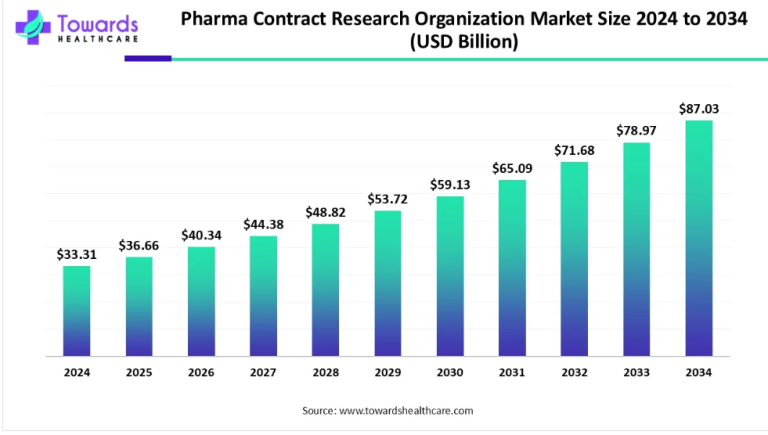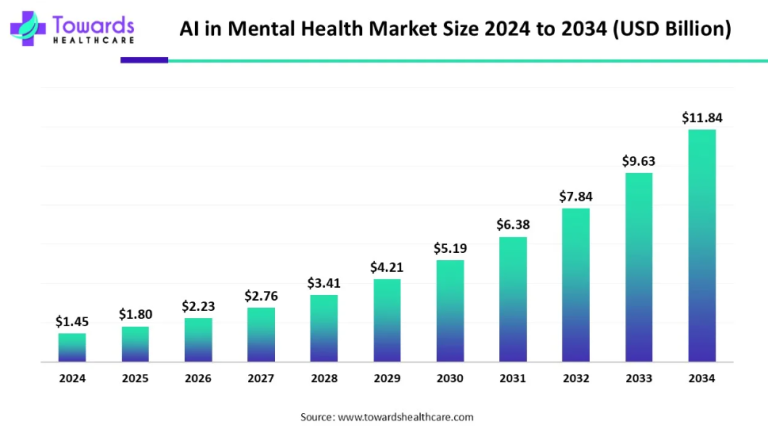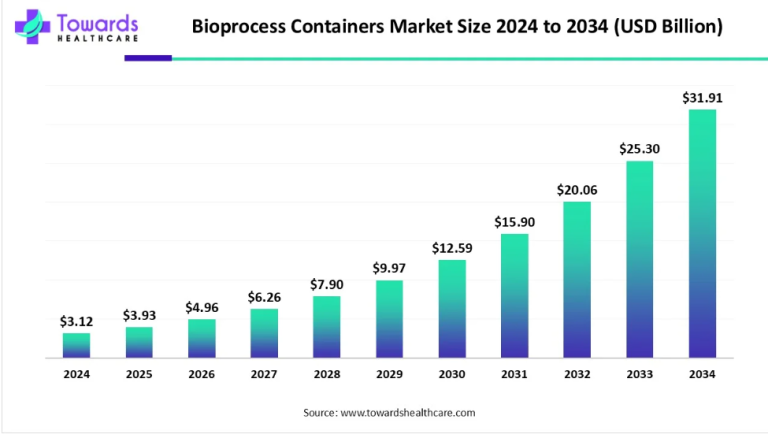Pediatric Drugs Market Surge at USD 363.86 Billion by 2032

Baby feeding with liquid medicine
The global pediatric drugs market is poised for substantial expansion. Starting at a valuation of USD 115.6 billion in 2022, this market is projected to surge to an estimated USD 363.86 billion by 2032. The driving force behind this remarkable growth is a noteworthy Compound Annual Growth Rate (CAGR) of 12.2% between 2023 and 2032. This upward trajectory is intricately linked to the escalating prevalence of pediatric disorders and the burgeoning pediatric population.
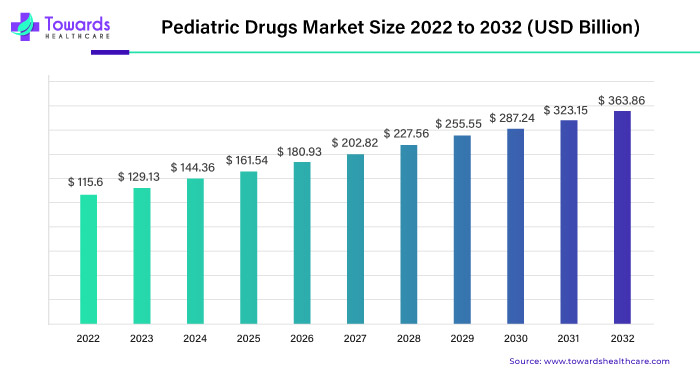
In March 2023, WHO released the first list of priority paediatric antibiotic compositions, enabling more concentrated research and development activities that tackle the specific requirements of infants and children.
Pharmaceutical companies are now working more on making medicines specifically for paediatrics, considering age, weight, and how their bodies develop. This is because children have unique traits that can affect how medicines work for them. The pediatric drugs market are growing because more kids are getting sick, and there are better ways to design drugs. But there are challenges, like figuring out the right amount of medicine for different ages and dealing with smaller groups of patients, which can make the drugs more expensive. Organizations like the European Medical Agency (EMA) and the Food and Drug Administration (FDA) are making rules to encourage research and ensure that medicines for children are safe and work well.
The market for pediatric drugs market is growing because kids often face health issues like stomach, allergy, and respiratory problems due to their weaker immune systems. This market includes drugs for conditions like breathing disorders, autoimmune diseases, stomach issues, heart-related problems, and others. Medicines can be taken orally, applied on the skin, injected, or through other ways. This market spans North America, Europe, Asia-Pacific, the Middle East, Africa, and Latin America, with specific data for 17 countries.
Individuals aged 2 to 12 receive pharmaceutical interventions specifically designed for pediatric use. The approach to pediatric therapy is fundamentally different from that of adults, primarily stemming from the imperative to tailor dosage regimens to the unique requirements of pediatric patients. Additionally, differentiation is imperative because the physiological response of a child to a given drug may diverge significantly from that observed in an adult population.
Thus, the distinct nature of pediatric therapy is essential for ensuring optimal efficacy and safety in this specific age group. Furthermore, the market experiences a positive impetus due to the expanding landscape of clinical trials aimed at introducing novel pediatric pharmaceutical products. This multifaceted synergy of elements substantiates the robust growth trajectory observed in the pediatric drugs market.
The following factors propel the pediatric drugs market growth
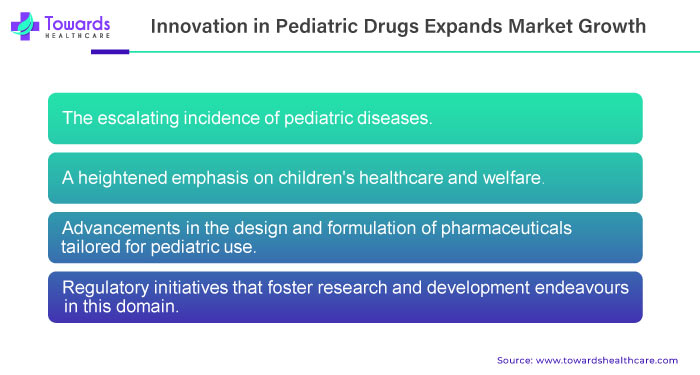
Table of Contents
ToggleInnovation in Pediatric Drugs Market Expands Growth
The expansion of the pediatric drugs market is driven by several factors, such as advancements in pediatric research, the broadening range of clinical trials, and increased investment in developing medications personalised for children. This trend creates substantial business prospects for pharmaceutical and biotechnology companies specialising in pediatric drug formulations. For instance, in August 2023, Aurobindo Pharma Ltd announced the release of their HIV triple combination medicine to pediatric patients in around 123 low- and middle-income countries.
Additionally, companies offering contract manufacturing services for pediatric pharmaceuticals stand to benefit. Collaborative research ventures, innovative drug delivery methods, and strategic partnerships with healthcare providers further facilitate market growth. Overall, these developments present promising opportunities for growth in the pediatric drugs market.
Some of the Recent Pediatric Oncology Drug Approvals by FDA:
| Approval Date | Drug Approved for Childhood Cancer | Indication |
| March, 2023 | Debrafenib | Trametinib , when used together, is approved for child aged 1 and older to treat Low grade Glioma (Brain Tumor) |
| February, 2023 | Nivolumab | This drug is given to Adults and children aged 12 and above with Melanoma. In addition, treatment is recommended to help prevent the cancer from coming back. |
| July, 2022 | Crizotinib | Treatment of adult and pediatric patients 1 year of age and older with Refractory inflammatory myofibroblastic tumor (IMT) |
| June, 2022 | Trametinib | For Adults and Pediatric Patient aged 12 and older with melanoma and lymph node involvement or metastatic disease post complete resection, adjuvant treatment is recommended |
Specialised Pharmaceutical Drugs is the Driving Force behind the Growth of the Pediatric Drugs Market
The wider utilization of off-label drugs in the pediatric population underscores the need for specialised pharmaceuticals customised to pediatric drug requirements, fueling innovation and expansion in the pediatric drug market. The expansion of the pediatric drug market is primarily driven by the increasing prevalence of health issues in children, including obesity, diabetes, asthma, and neurological disorders.
This has led to a rising demand for specialised pharmaceuticals personalised to the unique needs of the pediatric population. Recognising children’s distinct physiological and developmental characteristics, the pharmaceutical industry increasingly focuses on research and developing drugs specifically designed for them.
Respiratory Disorders Dominate Pediatric Drugs Market
The pediatric drugs market is anticipated to be predominantly influenced by the respiratory disorder drugs segment, which holds the largest market share. This is primarily attributed to factors such as compromised immunity, heightened pollution levels, and increased exposure to various allergens, leading to chronic respiratory disorders like Chronic Obstructive Pulmonary Disease (COPD). COPD, a significant contributor to the global pediatric healthcare burden, has seen a surge in demand for effective treatments. According to the World Health Organization (2021), COPD ranked as the third leading cause of global mortality in 2019, causing 3.23 million deaths.
The segment’s growth is driven by the escalating prevalence of rare autoimmune disorders linked to various cancers, genetic disorders, and other autoimmune conditions. The market is further propelled by initiatives to develop drugs for rare diseases, exemplified by the FDA’s approval of RUZURGI (amifampridine) tablets from Jacobus Pharmaceutical Company in May 2019. These prescription drugs, though associated with high costs, are contributing to the rapid growth of the global pediatric drugs market.
Rising Prevalence of Diseases in the Pediatric Population Expands the Pediatric Drugs Market Growth
The variance between the high rate of childhood illness, roughly 60%, and the narrow focus of pharmacological trials, about 12%, highlights the unrealized potential in the pediatric medication market. This disparity, coupled with a greater understanding of the particular healthcare requirements of children, has spurred more focus and funding for pediatric medication research. The growth of the pediatric medication business has also been aided by regulatory incentives, including pediatric exclusivity and an understanding of the moral need to address children’s health.
As a result, pharmaceutical companies are working harder on research and development projects to close this gap and satisfy the unique therapeutic needs of the diseases. They are mostly prevalent with childhood cancer in North America.
According to the Nationwide Children’s Hospital’s May 2023 estimates, in the U.S., around 90% of 17,000 paediatrics are diagnosed with cancer every year. 1,000+ Medical research grants at 150 institutions, 240+ Ongoing clinical trials funded each year. The increasing incidence of chronic disorders, encompassing conditions such as anorexia, asthma, congenital disabilities, growth deficiencies, diabetes, childhood cancer, juvenile diabetes, and attention deficit hyperactivity, is projected to positively impact the growth trajectory of the market. This surge in chronic disorders is a primary factor contributing to heightened demand for pediatric drugs market, consequently influencing the market dynamics throughout the forecast period from 2022 to 2032.
Obesity is one of the most prevalent conditions among children. For instance, according to data from the 2020-2021 National Survey of Children’s Health (NSCH), 17% of children aged 10 to 17 in the United States are obese. Obesity is a major problem that leads to several diseases like Type 2 Diabetes, Hypertension, Hyperlipidemia, Liver and kidney diseases, Hypertension, Cancer Risk and others.
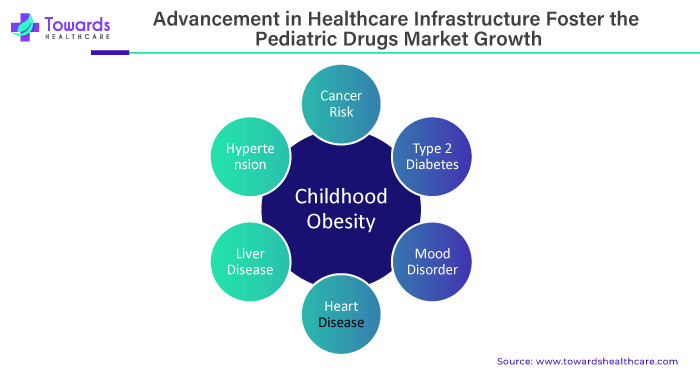
Advancement in Healthcare Infrastructure Foster the Pediatric Drugs Market Growth
The escalation of healthcare investment plays a pivotal role in shaping the trajectory of the pediatric drug market. A substantial determinant contributing to market growth is the surge in healthcare expenditure, facilitating the enhancement of healthcare infrastructure. Notably, government bodies are proactively augmenting this development by allocating increased funding to bolster healthcare facilities, exerting a profound impact on market dynamics.
Moreover, the concerted efforts of both public and private entities to raise awareness, coupled with a notable uptick in childhood obesity cases, are poised to further propel the pediatric drugs market. This phenomenon is further accentuated by evolving lifestyle patterns and a burgeoning population, collectively fostering the expansive growth of the pediatric drugs market. The convergence of these factors delineates a landscape where healthcare investments, governmental initiatives, and societal changes converge to drive advancements in pediatric pharmaceuticals.
Challenges Posed by Limited Market Exclusivity in Pediatric Drug Development
The abbreviated duration of market exclusivity poses a significant obstacle to the growth of the pediatric drugs market. In contrast to pharmaceuticals customised for adults, pediatric medications often face shorter market exclusivity and patent protection periods. This diminishes the financial allure for pharmaceutical companies to invest in pediatric drug development, as they are inclined towards markets where research and development investments can be recouped with substantial profits.
The pediatric sector encounters challenges due to smaller patient populations and limited exclusivity periods, making it more difficult to justify allocating resources for research and development. This limitation mainly affects the development of drugs for rare pediatric diseases, where patient numbers are exceptionally restricted.
Consequently, a considerable number of children resort to off-label use of medications intended for adults, posing potential risks to safety and effectiveness. Addressing this constraint necessitates policy and regulatory reforms that offer enhanced incentives for pediatric drug development, ensuring children can access secure and efficacious treatments.
Drug Type Segment Holds a Substantial Market Share
The paediatrics drugs market is categorized by type, encompassing analgesic and antipyretic, central nervous system drugs, especially antibiotics, gastrointestinal drugs, respiratory drugs, and vaccines. The segment held a significant market share, driven by children’s lower immunity, increasing pollution, and allergen exposure leading to chronic respiratory disorders, including Chronic obstructive pulmonary disease. Montelukast is notably employed for asthma prevention in children 2 years and older, particularly for exercise-induced bronchoconstriction.
The Autoimmune Disorders segment is anticipated to exhibit substantial growth, attributed to the rising incidence of genetic disorders, cancers, and cystic fibrosis. In addition, mental health problems sucg as anxiety, depression, ADHD, and behavioural problems are also common among children aged 5-27 years.
Percentage of Children and Adolescents Aged 5-17 Years Who Received Mental Health Medication Counselling or Therapy from a Mental Health Professional Between 2019 and 2022 in the U.S.
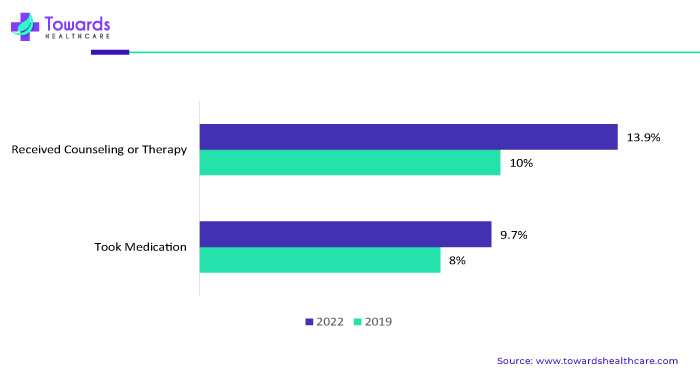 Additionally, the Pediatrics Medicine Market growth is further fueled by the inclusion of antibiotics, analgesics, antipyretics, respiratory drugs, gastrointestinal drugs, central nervous system drugs, vaccines, and others in the pediatric disease treatment spectrum. This comprehensive range contributes significantly to the overall market expansion.
Additionally, the Pediatrics Medicine Market growth is further fueled by the inclusion of antibiotics, analgesics, antipyretics, respiratory drugs, gastrointestinal drugs, central nervous system drugs, vaccines, and others in the pediatric disease treatment spectrum. This comprehensive range contributes significantly to the overall market expansion.
The Route of Administration Segment brings Substantial Growth in the Pediatric Drugs Market
The Pediatrics Medicine Market is categorized based on the route of administration, namely topical, oral, parental, and others. In 2020, the Oral segment dominated with the highest revenue share. This is attributed to the preference for non-invasive oral delivery in pediatric patients, minimizing pain and enhancing parental comfort, resulting in improved medication compliance.
This growth is driven by the minimal risk of adverse reactions and drug interactions, along with the ease of administration to children. Additionally, factors such as cost-effectiveness, lower drug quantities, and the concentrated application of antibiotics in affected areas contribute to the growth of this route of administration.
The Distribution Channel Segment expands the Pediatric Drugs Market Growth
- Hospital pharmacies can contribute to pediatric drug market growth by ensuring a consistent supply of specialized medications for young patients, collaborating with healthcare providers to optimize treatment plans, and counselling parents on medication administration.
- Retail pharmacies play a role by providing convenient access to pediatric medications, offering guidance to parents on proper usage, and facilitating prescription adherence. They contribute to growth by being a readily available resource for families seeking over-the-counter and prescription medications for their children.
- Online pharmacies enhance accessibility, especially for parents in remote areas. They can provide a wide range of pediatric medications, offer educational resources, and support telemedicine initiatives, making it easier for parents to consult healthcare professionals about their children’s health.
Collectively, these pharmacy settings create a comprehensive ecosystem that supports pediatric healthcare, ensuring accessibility, education, and adherence to medications for children.
Illuminating Factors: Understanding the Catalysts of Market Growth
1. Rising Prevalence of Pediatric Disorders: A Call for Specialized Healthcare Solutions
The surge in the pediatric drugs market is fundamentally driven by the increasing prevalence of pediatric disorders. As these conditions become more widespread, there is a growing demand for specialized pharmaceutical interventions tailored to the unique healthcare needs of children. This paradigm shift underscores the imperative for innovative and effective pediatric drugs.
2. Demographic Dynamics: The Upsurge in Pediatric Population
The burgeoning pediatric population globally is a pivotal factor contributing to the market’s exponential growth. With more children requiring healthcare interventions, there is a corresponding surge in the demand for pediatric drugs market. This demographic trend accentuates the need for a robust pharmaceutical landscape dedicated to catering to the distinctive requirements of pediatric patients.
Opportunities and Challenges: Navigating the Pediatric Drugs Market Landscape
Opportunities: Advancing Pediatric Healthcare
The burgeoning market offers opportunities to advance pediatric healthcare by developing targeted and effective pharmaceutical solutions. Innovations in formulations, dosage forms, and delivery mechanisms present avenues for creating medications that are not only efficacious but also palatable and convenient for pediatric patients.
Challenges: Ensuring Safety and Regulatory Compliance
Amidst the growth prospects, the pediatric drugs market faces challenges related to ensuring safety and regulatory compliance. Striking a balance between innovation and adherence to stringent regulatory standards is imperative to foster sustained growth and foster trust among healthcare practitioners and parents alike.
Conclusion: Paving the Way for Pediatric Well-being
In conclusion, the anticipated growth of the global pediatric drugs market signifies a paradigm shift towards prioritizing the health and well-being of the youngest members of society. The synergy between the escalating prevalence of pediatric disorders, the expanding pediatric population, and pharmaceutical advancements positions the market as a key player in shaping a future where children receive specialized, effective, and safe healthcare solutions. As we navigate this trajectory, the global pediatric drugs market emerges not only as a lucrative industry but, more importantly, as a beacon for nurturing the health and vitality of the next generation.
Geographical Landscape:
North America dominates the pediatric drugs market due to rising healthcare spending, supportive regulatory framework, and quick adoption of advanced technologies across the U.S. and Canada. The growth in this region is primarily attributed to its robust healthcare infrastructure, substantial research and development capabilities, and a significant pediatric patient demographic. The region’s dominance is further bolstered by favourable regulatory frameworks and government incentives, fostering the development and accessibility of pediatric medications. For instance, in 2021, US FDA approved the Rethymic drug for pediatric patients and used it to treat rare immune disorders. Rethymic is the 1st thymus tissue that is approved in the United States.
The market benefits from North America’s dedicated focus on pediatric healthcare heightened awareness among parents and healthcare professionals, and the region’s economic strength. Additionally, the presence of leading pharmaceutical companies further solidifies North America’s prominent position in the global pediatric drugs market.
During the forecast period, the Asia-Pacific region is poised for significant pediatric drug market growth. This expansion is driven by various vital factors, including the region’s substantial and expanding pediatric population, leading to an increased demand for specialized healthcare solutions for children. The economic prosperity and expanding middle-class demographic in Asia-Pacific also enhance affordability and accessibility to pediatric medications.
Government initiatives and increased regional healthcare investments are pivotal in fostering market growth. The pharmaceutical industry in Asia-Pacific is channelling more resources towards developing medications tailored for pediatric patients. This concerted effort has positioned the region as a significant influencer in the pediatric drugs market, emerging as a central hub for research, development, and distribution of pharmaceuticals for children.
Competitive Landscape
The pediatric drugs market are competitive, with a few big companies leading the way. Some of these companies have a larger share of the market. To stay ahead, some introduce new medicines to tackle existing problems, while others ensure they reach the people needing them.
In the past 10 years, pharmaceutical companies have increasingly chosen external organisations known as CROs, i.e. Contract Research Organisations, for their clinical trial and clinical research. A Tufts University and ICON PLC study predicts that by 2022, about 72% of global clinical trials will be handled by CROs. The combination of research and accessibility strategy allows these companies to stay ahead in the competitive landscape of pediatric medication.
Key Market Players:
- Pfizer Inc.
- Novartis International AG
- GSK plc.
- Sanofi S.A.
- AstraZeneca plc
- Merck & Co.,Inc.
- Johnson & Johnson
- Roche Holding AG
- Eli Lilly and Company
- Abbott Laboratories
Pediatric Drugs Market Segmentation:
By Drug Type:
- Antibiotic
- Analgesic
- Antipyretic
- Respiratory Drugs
- Gastrointestinal Drugs
- Central nervous system Drugs
- Vaccines
- Others
By Route of Administration:
- Oral
- Topical
- Parenteral
By Distribution Channel
- Hospital Pharmacies
- Retail Pharmacies
- Online Pharmacies
By Geography
- North America
- U.S.
- Canada
- Europe
- U.K.
- Germany
- France
- Rest of Europe
- Asia-Pacific
- China
- India
- Japan
- South Korea
- Rest of Asia Pacific
- Latin America
- Brazil
- Rest of Latin America
- Middle East & Africa (MEA)
- Saudi Arabia
- UAE
- South Africa
- Rest of the Middle East & Africa
READ MORE RELATED: AI in Breast Imaging Market
